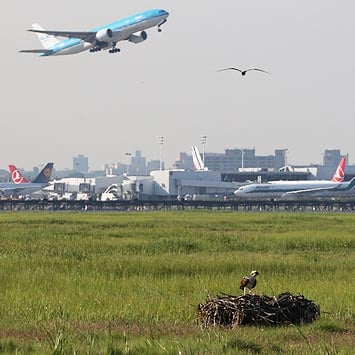Rooftop Refuges | New York
We know that green roofs cool our buildings and absorb storm water. But could they also provide habitat for wildlife? To find out, we got special access to five private rooftops in New York and Chicago.
Green roofs are like islands of green in a sea of concrete.
And scientists are finding that even in the densest urban neighborhoods, birds, insects, and even bats can find their way to these refuges.
On the 6.75-acre green roof at Manhattan’s massive Javits Convention Center—the second largest green roof in the United States—ecologist Kaitlyn Parkins has identified five different bat species. Parkins studies city bats in collaboration with the New York City Audubon and the Wildlife Conservation Society, and her identification method is unique. Parkins uses an acoustic monitoring application on her smartphone to record screeching bats in a spectrogram format, which provides visual sound frequencies that Parkins matches to each species.
Once a dangerous building for migrating birds, the Javits Center now provides a refuge to birds migrating in the spring and fall along the busy Atlantic Flyway.
Landscape biologist Dustin Partridge, a doctoral candidate at Fordham University, has observed thousands of insect species and dozens of bird species on the Javits roof. Partridge has been studying how green roofs provide habitat birds and insects in New York City since 2009.

Partridge has found that by attracting spiders and insects, the Javits Center’s roof provides a food source for migrating birds, and for several bird species that are making the Javits roof their permanent address, including nesting herring gulls.
Partridge also monitors the wildlife atop Goode Green—a green roof design and installation firm in Manhattan’s Little Italy neighborhood.
The rooftop at Goode Green has deeper soil than the one at the Javits Center—it’s what’s known as an “intensive” green roof. While an intensive roof can require more maintenance, Partridge said that the deeper soil allows gardeners to plant taller shrubs and trees. With the diversity of flowering plants and fruit-bearing trees at Goode Green, Partridge has learned that the roof is supporting more wildlife species, including a variety of birds, bees, and butterflies.
In Chicago, botanist Kelly Ksiazek-Mikenas, a PhD candidate and presidential fellow at Northwestern University, is experimenting with native Illinois plants on green roofs.
Ksiazek-Mikenas is trying to figure out whether roofs can provide suitable habitat for prairie plants, and whether the plants can reseed and persist there. Ksiazek-Mikenas grows an assortment of shortgrass prairie plants on the 5,900-square-foot green roof at the Chicago Academy of Sciences’ Peggy Notebaert Nature Museum, and the Quinlan Life Sciences Building at Loyola University Chicago.
While the jury is still out on the ability of prairie grasses to absorb water and maintain temperatures as well as traditional green roof plants, Ksiazek-Mikenas’ research is indicating that the native species are reseeding and replicating, and are providing food and nectar to insects and birds.
As the conventional habitat for some of these plant and animal species is disappearing, the evidence is mounting that green roofs can become critical refuges.

— Sean Keenehan






